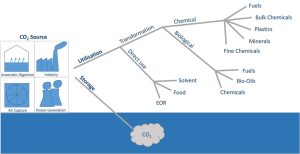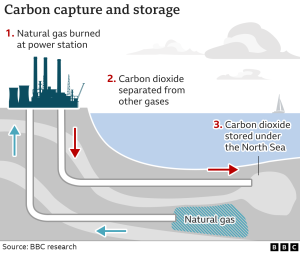Can Capturing Carbon Stop Global Warming?
Written by: Chad Park
Global warming is a real threat, and one of the primary causes is carbon dioxide. The Earth’s most abundant greenhouse gas, carbon dioxide levels, have risen over 90% since the 1970s, reaching a record high of 417.06 parts per million (ppm) in 2022. The ice caps are melting, ocean levels are rising, and the Earth is in jeopardy. With the increasing need to live sustainably, efficient ways to eliminate carbon dioxide are crucial. Enter carbon capture and utilization. Carbon capture and utilization (CCU) is a process where carbon dioxide is captured from sources like power plants and facilities and then utilized for more beneficial purposes instead of just allowing the carbon dioxide to be released into the environment.
How Does CCU Work, Exactly?
There are three main ways carbon is captured: post-combustion, pre-combustion, and oxyfuel combustion. In post-combustion, carbon dioxide is captured from the combustion of fossil fuels involving the use of chemicals (like phosphite to activate and make the carbon dioxide more reactive) to absorb the carbon dioxide. Pre-combustion is when the carbon dioxide is captured before the fossil fuel combustion is completed. This process starts with the initial partial burning of the fossil fuel in a gasifier to create synthetic gas, a mixture of carbon monoxide (CO), carbon dioxide CO2), and small amounts of several other gasses. The synthetic gas is then subjected to the water-gas shift reaction to convert CO and water (H2O) to H2 and CO2. The carbon dioxide from the resulting mixture can then be captured, and the remaining hydrogen can be combusted to release energy. In oxyfuel combustion, the fossil fuel is burned in oxygen. The resultant flue gas mostly consists of CO2 and water vapor. Cooling causes the water to condense, producing nearly pure CO2 that may be transported and stored. Oxyfuel combustion is an example of “zero emission,” as nearly all the carbon dioxide is captured through an absorption process where the flue gas is brought into contact with an amine-based solution in an absorption column. After the amine-based solution has absorbed the CO2, the CO2 is effectively “stripped” from the amine-based solution through the use of catalysts to facilitate the process.

Figure 1. Examples of Carbon Dioxide Utilization Path
Source: frontiersin.org
How is carbon dioxide transferred and stored?
After carbon dioxide is captured, it is mainly pumped through pipes to storage. Other methods include transportation through ships and trucks. Carbon dioxide is commonly stored in three different ways: deposition into geological formations, deposition in the ocean, and reaction with minerals. In geological storage, the carbon dioxide is compressed into a dense state. The compressed carbon dioxide is injected deep into the geological formation at the geological site. Common formations compatible with geological storage include inaccessible coal mines, depleted oil reservoirs, and deep saline aquifers. In ocean storage, the carbon dioxide is injected into the ocean deep below the sunlit zone. The carbon dioxide then dissolves in the seawater, where it can be stored for hundreds of thousands of years. In mineralization, carbon dioxide is artificially reacted with iron, magnesium, and calcium materials. These carbonate compounds are highly stable and result in the long-term storage of carbon dioxide in a solid form.

Figure 2. Storing of Carbon Dioxide Through Ocean Storage
Source: bbc.com
What Are the Costs and Risks of CCU?
CCU is both expensive and risky. Costs are connected with capturing carbon dioxide emissions from industrial operations and the energy necessary for capture, transport, or utilization. Furthermore, some risks of CCU include possible carbon leakage, technical challenges, and long-term liability. Economic feasibility and regulatory uncertainty also present financial concerns.
Conclusion
Carbon capture and utilization (CCU) presents a promising avenue for addressing the pressing issue of global warming by capturing and repurposing carbon dioxide emissions. While it offers potential benefits in reducing greenhouse gas levels and mitigating climate change, CCU has challenges, including high costs and inherent risks. Its success hinges on continued research and development and practical regulatory frameworks to ensure its economic viability and environmental sustainability. As part of a broader strategy to combat global warming, CCU holds promise but requires concerted efforts and innovation to realize its full potential in safeguarding our planet’s future.
References and Sources:
Carbon capture, Utilization & Storage. Energy.gov. (n.d.). https://www.energy.gov/carbon-capture-utilization-storage#:~:text=Carbon%20capture%2C%20utilization%20and%20storage,will%20not%20enter%20the%20atmosphere.
Fransen, B. (2022, November 21). Carbon capture and utilization (CCU). EcoMatcher. https://www.ecomatcher.com/carbon-capture-and-utilization-ccu/
Global Greenhouse Gas Emissions Data | US EPA. (n.d.). https://www.epa.gov/ghgemissions/global-greenhouse-gas-emissions-data
Iea. (n.d.). Carbon capture, utilisation and storage – energy system. IEA. https://www.iea.org/energy-system/carbon-capture-utilisation-and-storage
Understanding carbon capture and storage. British Geological Survey. (2022, November 16). https://www.bgs.ac.uk/discovering-geology/climate-change/carbon-capture-and-storage/#:~:text=The%20concept%20is%20to%20capture,ground%20surface%20or%20sea%20bed.